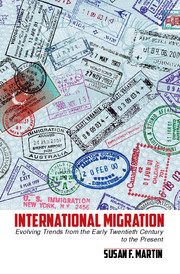Book contents
- Frontmatter
- Contents
- Foreword
- Acknowledgments
- List of Acronyms
- Introduction
- 1 Early Roots
- 2 “The Problem of Refugees”
- 3 Labor Mobility
- 4 Orderly and Humane Migration Management
- 5 Trafficking in Persons
- 6 Migration and International Security
- 7 Migration, the Environment, and Climate Change*
- 8 Migration and Development
- 9 Towards the Future
- Bibliography
- Index
4 - Orderly and Humane Migration Management
Published online by Cambridge University Press: 05 August 2014
- Frontmatter
- Contents
- Foreword
- Acknowledgments
- List of Acronyms
- Introduction
- 1 Early Roots
- 2 “The Problem of Refugees”
- 3 Labor Mobility
- 4 Orderly and Humane Migration Management
- 5 Trafficking in Persons
- 6 Migration and International Security
- 7 Migration, the Environment, and Climate Change*
- 8 Migration and Development
- 9 Towards the Future
- Bibliography
- Index
Summary
This chapter focuses on the International Organization for Migration (IOM), the successor to PICMME. A full chapter on IOM is warranted because the agency, although outside of the UN system, has the strongest capabilities to take on the range of activities needed if an international migration regime were to be adopted. The chapter discusses IOM's history and current role. The title is taken from its designated strategic mission “to facilitate the orderly and humane management of international migration” (IOM 2007).
IOM has 155 member states and 11 state observers, and operates in 470 field locations in more than 100 countries. The agency works in four broad areas of migration management that correspond to the agendas of many states: (1) migration and development; (2) facilitating migration; (3) regulating migration; and (4) addressing forced migration. IOM activities that intersect these areas include the promotion of international migration law, policy debate and guidance, protection of migrants’ rights, migration health, and the gender dimension of migration. IOM provides a range of services related to building the capacity of states to manage migration, migrant health, migration and development, return assistance, and counter-trafficking. The organization also serves as secretariat to many regional consultation mechanisms and houses a light support structure for the Global Forum on Migration and Development.
- Type
- Chapter
- Information
- International MigrationEvolving Trends from the Early Twentieth Century to the Present, pp. 124 - 153Publisher: Cambridge University PressPrint publication year: 2014

